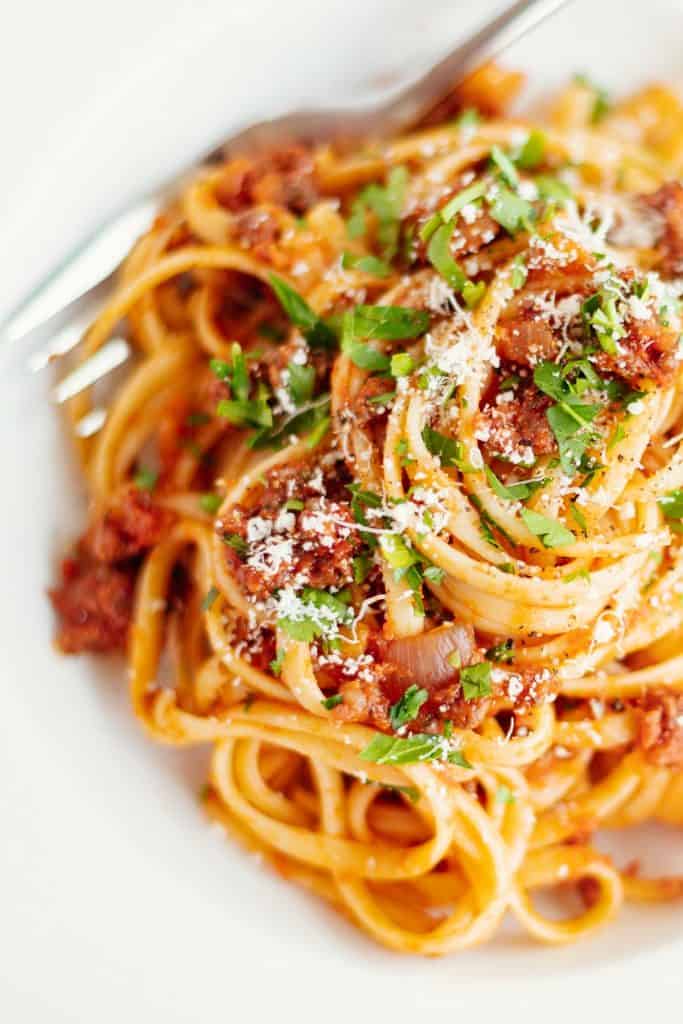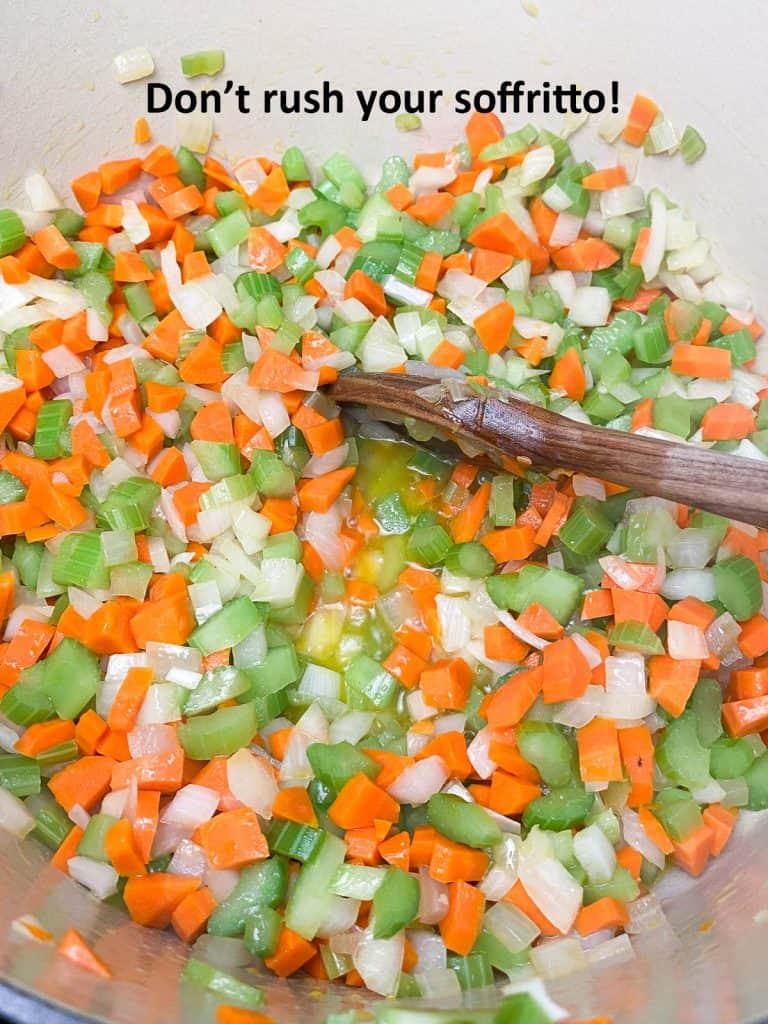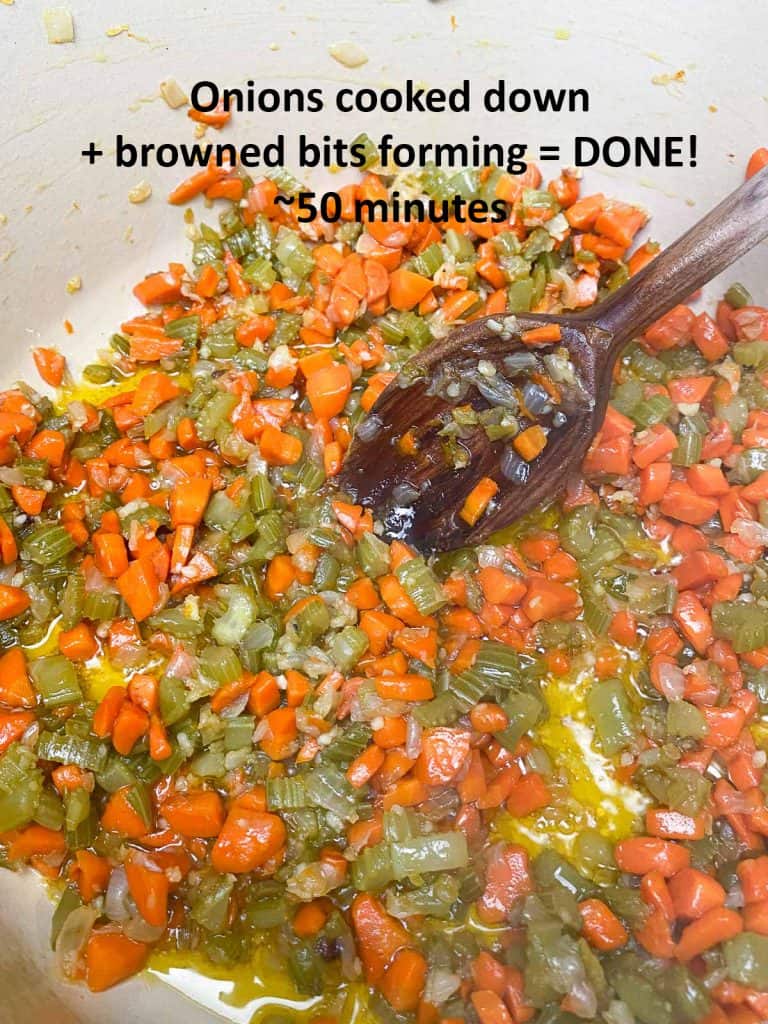My very first recipe! Traditional Ragu Bolognese is a very meat-forward dish, and that's not what comes to mind when you think of the Mediterranean Diet. But this recipe uses a lot of different techniques to boost and develop a complex, rich flavor, which is one of the strategies I use so that I need less meat to feel satisfied. A half a cup of this sauce packs a ton of yum into a variety of healthy meals!

Have you ever made a dish that you can’t stop thinking about even after you’ve stuffed yourself full, cleaned up the kitchen and gone to bed? This Ragu Bolognese is one of those recipes for me. It’s just an Italian meat sauce, but man, I can’t stop eating it...with a spoon...straight out of the fridge. I’m glad I made a big batch!
What is Ragu Bolognese?
I feel like a lot of people have a fundamental misunderstanding of what Ragu Bolognese is. It is NOT marinara sauce with meat added in! Ragu Bolognese is very meat-forward, and generally not what I would call saucy. In fact, some knowledgeable folks will tell you there is little or no tomato in a traditional Ragu Bolognese. But the godmother of Italian cooking, Marcella Hazan, calls for tomatoes in her famous recipe, so I feel confident doing so too (although I make zero claims as to the overall authenticity of this recipe).
The magic of soffritto
The big secret to an amazing Ragu Bolognese is to start with soffritto. Soffritto is a combination of aromatics (usually onions, carrots, and celery) that is cooked slowly in olive oil to create a caramelly vegetable base. It takes a solid 45 minutes to an hour to cook a soffritto properly, but--thankfully--only a little bit of hovering and stirring. It does add some time to the beginning stage of your sauce, but it can also be made ahead and refrigerated or even frozen. Have lots of patience for this step...the payoff is so worth it! Don't be tempted to crank the heat and brown your vegetables, or cut off the cooking time before they have started to almost disintegrate.



(Side note: for the best soffritto, chop you veggies smaller than you what you see above. I had a bad day with the arthritis in my hands when I was chopping these. You want it to be almost a mince.)
You've taken all this time to make the perfect soffritto...
This is one recipe where the quality of your ingredients absolutely impacts the outcome of the dish! Don't ruin a beautiful soffritto by skimping on any of the other ingredients in your Ragu Bolognese. I could wax poetic on every single one, but I know you’re in a hurry to get to the recipe, so here is the Cliff’s Notes version:
- Whenever possible, use imported San Marzano-style tomatoes from Italy. I could go on and on about this, but seriously, trust me! San Marzano tomatoes are SO much better, particularly if they are marked D.O.P, which certifies that they are truly a product of Italy. I really like the Cento Organic D.O.P., which are widely available, but my very, very favorite imported canned tomato is Strianese brand, and I find them at Cost Plus World Market.
- Use high-quality extra virgin olive oil. Hopefully this is obvious! For more information about how to choose great olive oil, check out this article from DeLallo. Costco's Organic Extra Virgin Olive Oil is an excellent and cost-effective choice and the one I use most in my cooking, but I'm always scanning the shelves at Cost Plus World Market for an excellent imported olive oil at a great price.
- Use a decent quality wine. I won't ask you to crack that bottle of white Bordeaux that you've been saving for a special occasion, but you definitely don't want to use anything of the "two buck chuck" variety. And definitely nothing sweet! I usually use a moderately priced sauvignon blanc.
- Be aware of salt. The recipe calls for one teaspoon of kosher salt, but that’s really just a starting point. You will need more, but the amount you need will vary depending on the saltiness of your canned tomatoes. Taste, taste, taste! I usually taste and adjust salt at least twice in the last 5 minutes of simmering.
Get creative with your finished product
This Ragu Bolognese sauce takes some time, but the outcome is worth every minute. Serve it over whole wheat linguine or roasted spaghetti squash with a simple side salad. Stuff the leftovers into zucchini squash boats and top with a little shredded mozzarella for a midweek meal. Make a double batch and freeze the extra to use in a pan of zucchini noodle lasagna later on. Or, be like me and eat it straight out of the fridge whenever the mood overtakes you!
Ragu Bolognese
Equipment
- Dutch oven
Ingredients
- ⅓ cup High-quality extra virgin olive oil
- 1 Large white or yellow onion, diced
- 3 Medium-sized carrots, diced
- 3 Stalks of celery, diced
- 1 pound Ground beef
- ½ pound Ground pork or mild Italian sausage
- ½ teaspoon Crushed fennel seed
- 3 Cloves of garlic, minced
- 3 tablespoons Tomato paste
- ½ cup Milk
- 1 cup Dry white wine
- 1 28-ounce can whole San Marzano tomatoes
- 1 teaspoon Salt (plus more to taste)
- Several cranks of freshly ground black pepper (to taste)
- 1 tablespoon Dried oregano
- Grated Parmesano-Reggianno, for serving
Instructions
- Heat the olive oil in a Dutch oven over medium heat and add the onions, carrots, and celery.
- Sautee for 45 minutes, stirring occasionally, until the vegetables are soft and have developed a light caramel color. Turn the heat down as necessary to prevent the vegetables from browning or burning. You will get brown bits on the pan, that's fine, just make sure the vegetables themselves are not browning.
- Crumble in the ground beef and pork or sausage, then add the garlic and crushed fennel. Cook until browned and most of the fat has cooked off, approximately 15-20 minutes. Use your spoon to break down the meat into a small crumble.
- Add the tomato paste and work it into the meat. Continue cooking, stirring, until the tomato paste begins to leave caramelized brown bits on the bottom of the pan, 5 minutes or so. If it starts to burn, turn down the heat.
- Add the milk and stir for 3 to 5 minutes until it is mostly absorbed and coating the meat and vegetables.
- Add the wine and stir, scraping up any browned bits on the bottom of the pan. Let it simmer until reduced by two-thirds, 3-4 minutes.
- Add in the tomatoes, salt, pepper and oregano and bring to a simmer, breaking up the tomatoes with your spoon.
- Simmer for 30 minutes, stirring frequently and continuing to break up the tomatoes as they cook. Turn down the heat if it starts scorching on the bottom of the pan. Once or twice during simmering, taste for seasoning and add a pinch or two of salt if necessary.
- Taste for seasoning and adjust if necessary.
- Serve over freshly-cooked fettucine or roasted spaghetti squash, topped with grated Parmesano-Regianno.
Notes
Need more servings?
To adjust a recipe for more or fewer servings, hover your cursor over the number servings on the recipe card. This will bring up a slider that you can move to the number of servings you want to make.



dagny says
yay mom! very tasty.